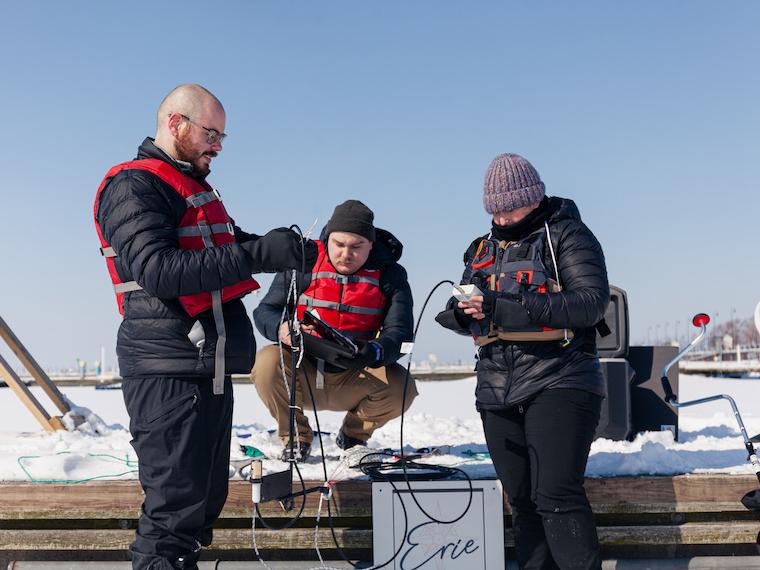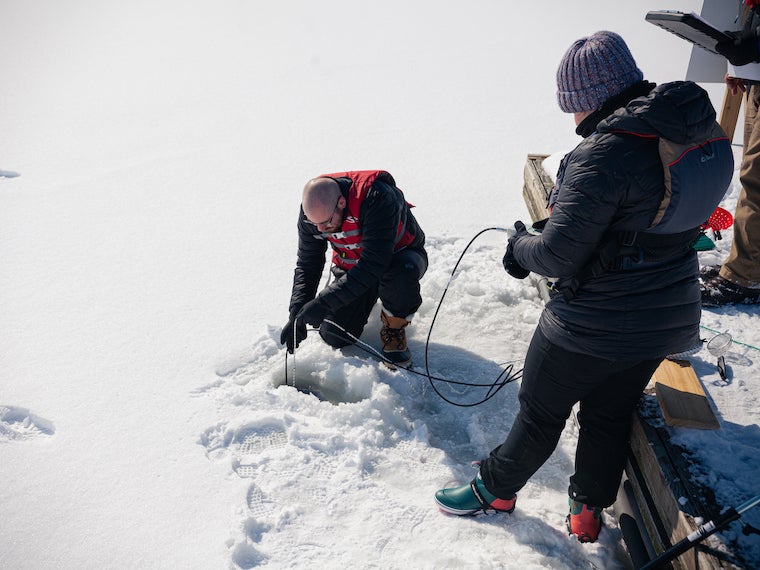Geology Research Team Joins Winter Campaign to Study the Great Lakes
February 21, 2022
Scott Wargo

Photo credit: Office of Communications
Assistant Professor of Geology Rachel Eveleth is collaborating with scientists from more than a dozen universities in the Winter Grab, a first-of-its-kind research initiative to better understand the ecology of the Great Lakes. One of the world’s largest surface freshwater ecosystems, the Great Lakes account for 84 percent of North America's surface fresh water and about 21 percent of the world's supply of surface fresh water.
Most scientific sampling of the Great Lakes is completed during warmer months when the lakes are free of ice, so the Winter Grab will provide the wintertime data that is necessary to fill the information void. Led by the University of Minnesota Duluth, the scientists will gather data that is necessary to more fully comprehend summer events such as toxic algal blooms and fish die offs.
Eveleth and student researchers Peter Zimmerman ’22 and Jonas Mondschein ’22 transported their gear to the marina at Port Lorain and collected samples from Lake Erie. Standing on the frozen lake, they drilled holes through six inches of ice to collect water samples, measure light levels at various depths, and net tiny zooplankton. Eveleth received funding to participate in the Winter Grab from Oberlin’s Grant in Aid program. Learn more about her research and the Winter Grab in this Q&A.
The goal of the Winter Grab is to help fill key wintertime knowledge gaps about ice properties, water movement, nutrient concentrations and lake biology. What do you hope to learn from the information that is collected and what implications could that have on the future of the Great Lakes?
There is still so much to learn because the gaps are so large! It’s rare to have such an interdisciplinary study that covers all five Great Lakes, especially in winter, so it will be really interesting to be able to say how things like ice, water quality, water chemistry, and biology all relate to each other. I study oxygen and carbon cycling in the Great Lakes, so my eyes will be particularly tuned to those data. What happens in winter and early spring sets the stage for summer problems like toxic algal blooms and fish die-offs because of low oxygen. It is very difficult to predict, model, and manage these problems if we don’t know what’s happening during half the year. The region is also warming due to climate change, but it’s impossible to say for sure how it will change in the future if we don’t even know what is going on right now. This is a great step in the right direction.
Researchers from more than a dozen institutions will participate in the Winter Grab conducting research at locations across the Great Lakes. What is your role in the project, and how are the various research initiatives connected?
Our group started planning the Grab last summer, deciding on optimum timing, core analyses, and responsibilities. Each team will collect a series of core measurements and samples at a site close to them. To standardize measurements, different labs will be in charge of processing all of the samples for each different analysis. Our group will be sampling in the Lorain Harbor of Lake Erie, and then we will be in charge of measuring alkalinity for all of the sites. After all the data has been processed, the full group will pull it all together to see how processes are interrelated and how values vary throughout the Great Lakes.
What specific information will you be gathering, what will be the process for collecting that information?
Our group will be cutting a hole in the ice next to a dock in Lorain, Ohio, making observations of the ice, measuring light transmittance through snow, ice, and water, measuring water properties (temperature, conductivity, pH, oxygen), collecting water samples for lab measurements (nutrients, chlorophyll, alkalinity, organic carbon, microbial composition, chloride, toxins, productivity) and collecting zooplankton using a net tow to see what they eat in winter. Each group will be following the same procedure but at different locations.

I will be titrating approximately 120 filtered water samples to measure alkalinity. Alkalinity is the ability for water to buffer changes in pH. We will all also measure pH in the field. With these two measurements we will be able to calculate an estimate of dissolved CO2. It is unknown whether the Great Lakes are annually taking up CO2 from the atmosphere or releasing it to the atmosphere, in large part because we have extremely limited winter data. These data will help us better understand and predict future climate change.
You have several students working with you, what is their role in the research and how does this fieldwork compliment their other coursework?
I am currently on pre-tenure research leave so I don’t have semester-long research students. However, I thought this was a great opportunity to introduce students to a wide variety of limnological analyses and field techniques. Geology majors Peter Zimmerman and Jonas Mondschein joined me in the field and helped process the samples. This is Jonas’ first time working with me and Peter comes to the project with experience in winter limnology. During Winter Term 2020, Peter and another student, Eliza Goodell ’22, lived and worked alongside me on South Bass Island in Lake Erie measuring productivity, oxygen, and carbon dynamics.
How has climate change affected the ice cover on the Great Lakes and how does that impact the ecology of the lakes?
While there is variability from year to year, air and water temperatures are rising and ice cover is declining. The implications of these changes on physical processes such as water circulation, water levels, and precipitation are better known than ecological impacts. For example, less ice may lead to more light penetration into the water supporting phytoplankton blooms, but if there is more snow cover on the ice because of warmer moist air, light might decrease. Early ice melt and warmer temperatures might change timing of blooms or spawning of commercially fished species such as lake trout. If we see more biological activity in the winter, it might also shift carbon budgets and influence climate. We still have so much to learn!
How will this work support further research on the Great Lakes?
We hope this Grab will draw attention to research and management needs in the winter, and also lead to future collaborations and grant proposals. It has been really exciting getting more established in this budding research community and already starting to develop new collaborative project ideas as offshoots of this Grab.
Is your work with the Winter Grab related to any of your ongoing research?
My background when I started at Oberlin was in polar oceanography. I saw an amazing opportunity to bring some of those skills and knowledge to bear on a system in our backyard that also very directly impacts people’s lives in terms of drinking water health, recreation, and commercial fisheries. The Grab is directly in line with my ongoing research priorities and builds off of our Winter Term work from 2020. I hope this is the first annual Grab and that I continue collaborations with the group. I’d also love to establish a regular sampling site, maybe in Lorain, so we can collect a timeseries of how properties are changing. I also have another funded project this year that will be looking at the relationship between algal blooms, carbon, and oxygen through the spring, summer, and fall in Lake Erie. The Grab will provide some winter context for what we see later in the year.
You may also like…
Friday Afternoon with Lab Crawl
This year’s Lab Crawl drew what may be the largest crowd in the event’s illustrious history, with some 500 students and dozens of faculty taking part. Missed out on the excitement? It looked something like this.
Lab Crawl: It’s Not Just for Scientists
Oct. 27 open house highlights research across the sciences—and just about everywhere else.
In the Path of Disaster
Monica Dix travels to a hub of natural calamity to probe its risks and resilience.


